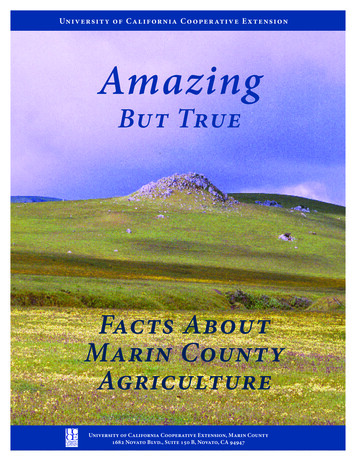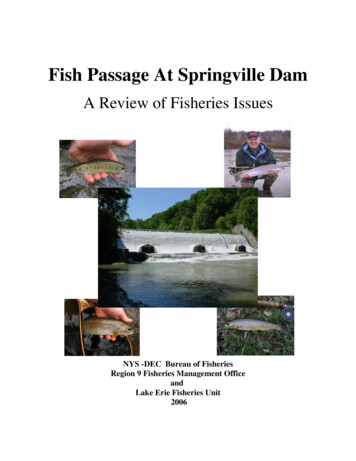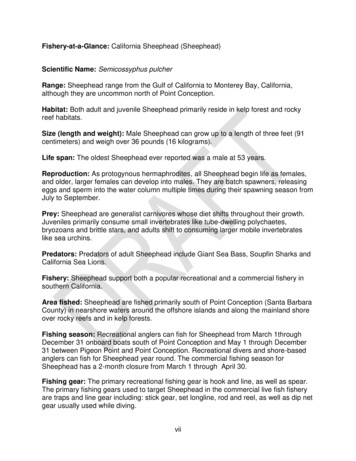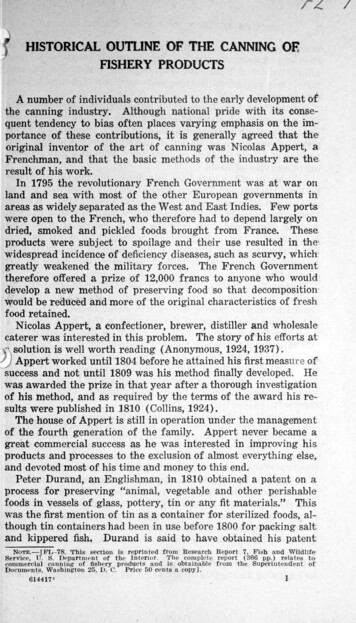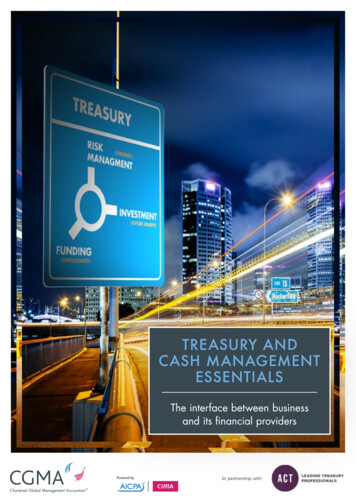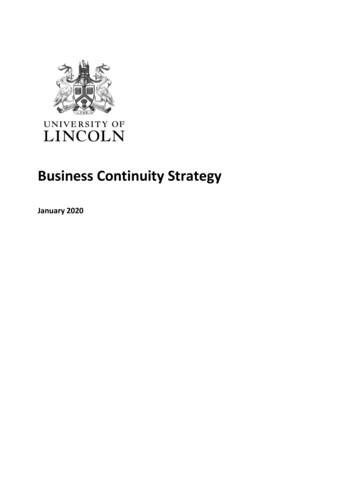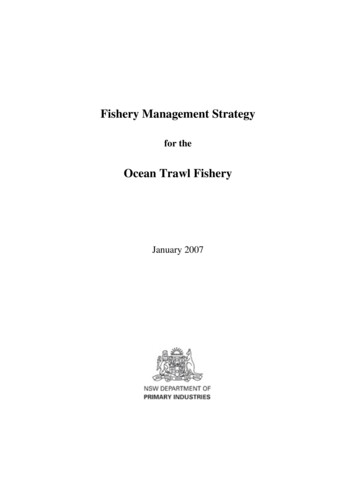
Transcription
Fishery Management Strategyfor theOcean Trawl FisheryJanuary 2007
Fishery Management Strategy for the NSW Ocean Trawl FisheryPublished in March 2007by the NSW Department of Primary Industries202 Nicholson ParadeCRONULLA NSW 2230(PO Box 21 CRONULLA NSW 2230)ISBN 978 0 7347 1799 3Copyright 2007 NSW Department of Primary IndustriesApart from any fair dealing for the purposes of private study, research, criticism or review, as permittedunder the Australian Copyright Act, no part of this publication may be reproduced by any process withoutwritten permission from Department of Primary Industries. Inquiries should be addressed to Department ofPrimary Industries.Disclaimer: Any representation, statement, opinion or advice, expressed or implied in the publication ismade in good faith and on the basis that the State of New South Wales, its agents and employees are notliable (whether by reason of negligence, lack of care or otherwise) to any person for any damage or losswhatsoever which has occurred or may occur in relation to that person taking or not taking (as the case maybe) action in respect of any representation, statement or advice referred above.The Fishery Management Strategy for the Ocean Trawl Fishery will be updated from time to time.Amendments will be made available on the NSW DPI website:http://www.dpi.nsw.gov.au/fisheries
Fishery Management Strategy for the Ocean Trawl FisheryiiiTable of ContentsTable of Contents .iiiList of Tables .vList of Figures.viAbbreviations .vii1. Introduction .9a) Background to the Fishery Management Strategy .9b) The Ocean Trawl Fishery .10c) Vision and Goals of the Ocean Trawl Fishery .10i) Fishery Vision .10ii) Fishery Goals.102. Relevant Legislation and Policy .12a) Ecologically sustainable development .12b) The Fisheries Management Act.12c) Arrangements with the Commonwealth and other States .13d) Fishery management framework .13e) The NSW Environmental Planning and Assessment Act.14f) The Commonwealth Environment Protection and Biodiversity Conservation Act .14g) The NSW Marine Parks Act.15h) Changes to Regulations . 15i) Indigenous Fisheries Strategy.163. The Harvest Strategy .17a) Extent of the Fishery .17i) Number of fishers .17ii) Area of operation .17iii)Activities endorsed in the fishery .19iv)Fishing gear used in the fishery.20v) Boats used in the fishery.21b) Species .22i) Species allowed .22ii) Bycatch species .23iii)Size limits .24iv)Protected species .25v) Status of species within the fishery .25vi)Overfished species.27vii)Species in the fishery determined as being overfished.29c) Management controls and administration.31i) Limited entry .31ii) Commercial fishing licences .31iii)Fishing boat licensing.33iv)Renewal of licences .34v) Transfer policies .35vi)Appeals mechanisms .36vii)Code of practice.36viii) Time and area closures .37ix)Zoning.37x) Permits .38xi)Catch limits or quotas .38xii)Seafood safety programs .38January 2007
ivFishery Management Strategy for the Ocean Trawl Fisheryxiii) Cost recovery policy . 38Compliance . 39Research . 40i) Proposed research areas . 40ii) The Conservation Technology Unit. 48iii)Catch monitoring. 48f) Consultation . 50i) Management Advisory Committees. 50ii) Ministerial advisory councils . 50g) Interactions with Other Fisheries . 51i) Other NSW commercial fisheries . 51ii) Commercial fisheries in adjacent jurisdictions . 51iii)Recreational fishery . 52iv)Indigenous fishery. 524. Goals, Objectives and Management Responses. 53a) A model framework . 53b) Goals, objectives and management responses . 555. Performance Monitoring and Review . 84a) Performance monitoring . 84i) Performance indicators . 84ii) Trigger points. 84b) Predetermined review of performance indicators and trigger points. 85c) Reporting on the performance of the management strategy . 85i) Performance assessment and report . 85ii) Review report in response to trigger points . 86d) Contingency plans for unpredictable events . 95e) Monitoring performance of resource assessment. 95References. 97Appendices to the FMS. 99Appendix 1. Copy of Minister’s determination made under the EP&A Act. 100Appendix 2. Implementation table. 102Appendix 3. Supporting policy for ocean trawl bycatch reduction and prawn yields. 111Appendix 4. Specific management arrangements for trawling for whiting. 116Appendix 5. Classes of resource assessment for species harvested in NSW . 117d)e)January 2007
Fishery Management Strategy for the Ocean Trawl FisheryvList of TablesTable 1.Snapshot of the major marine commercial fisheries in NSW .11Table 2.Numbers of fishing businesses by endorsement type in the OTF .20Table 3.Primary and key secondary species in the OTF. .23Table 4.The characteristics of the categories of exploitation status that are used todetermine the status of key species, as part of the resource assessment system .26Table 5.Exploitation status of primary and key secondary species taken in the OTF. 27Table 6.Summary of the attributes of the various classes of resource assessment.43Table 7.A summary of the proposed target resource assessment classes for primary andkey secondary species of the fishery .44Table 8.Robustness Classifications .84Table 9.Performance indicators and trigger points for the fishery. .88Appendix 2.Implementation table for the OTF .103Appendix 3.Bycatch and prawn yield closure specifications.114January 2007
viFishery Management Strategy for the Ocean Trawl FisheryList of FiguresFigure 1.Figure 2.Figure 3.objectives.Map of the area of the OTF including identification of major ports. 18A model of the framework for a fishery management strategy. . 53An example of how a single management response affects multiple goals and. 54January 2007
Fishery Management Strategy for the Ocean Trawl FisheryAbbreviationsARCDEHEISEP&A ActEPBC ActESDFM ActFMSFRDCIFSMACMLLnmNSWNSW DPIOCSOTFOT MACAustralian Research CouncilDepartment of the Environment and Heritage (Commonwealth)Environmental Impact StatementEnvironmental Planning and Assessment Act 1979Environment Protection and Biodiversity Conservation Act 1999Ecologically sustainable developmentFisheries Management Act 1994Fishery management strategyFisheries Research and Development CorporationIndigenous Fisheries StrategyManagement Advisory CommitteeMinimum legal lengthNautical milesNew South WalesNSW Department of Primary IndustriesOffshore Constitutional SettlementOcean Trawl FisheryOcean Trawl Management Advisory CommitteeJanuary 2007vii
Fishery Management Strategy for the Ocean Trawl Fishery1.a)9IntroductionBackground to the Fishery Management StrategyIn December 2000, the NSW Government made changes to the way fisheries are managed inNSW. These changes place increased emphasis on ensuring that fishing activities are environmentallysustainable. The changes require the development of a fishery management strategy for each majorcommercial fishery, fish stocking and for the beach safety program. They also require an assessmentof the environmental impacts of those fishing activities.The fishery management strategy (FMS) for the Ocean Trawl Fishery (OTF) is much morethan a collection of rules for the fishery. The strategy contains the vision, goals and objectives for thefishery, a broad description of the way the fishery operates, and outlines the future managementframework. It also outlines a program for monitoring the performance of the fishery against themanagement goals. Where necessary, information about the impacts of harvesting by other fishingsectors (such as recreational fishing) is also provided, however the rules contained in this FMS applyonly to the OTF. The rules applying to other commercial and non-commercial fishing sectors areseparate management arrangements and are not the subject of this strategy.The Management Advisory Committee (MAC) for the OTF provided significant input into thedrafting of this strategy. Input into the draft strategy was also sought from all fishers endorsed in theOTF, the Ministerial advisory councils on the seafood industry and recreational fishing, and theFishery Management Strategy Working Group. Government agencies, such as the NSW Departmentof Planning and the Commonwealth Department of the Environment and Heritage, have also beenconsulted throughout the drafting of the FMS.An Environmental Impact Statement (EIS) was prepared for the OTF and publicly exhibited inAugust/September 2005. The EIS contained the draft FMS and an assessment of the environmentalrisk mitigation measures contained therein. The structure of the EIS was based on guidelines issuedby the NSW Department of Planning (formerly Planning NSW), including an assessment of thebiophysical, social and economic impacts of implementing the draft management strategy.The EIS highlighted the importance of the OTF to the community in terms of employment,supply of seafood to the community and economic benefits. The EIS concluded that, although therewere several existing environmental risks, the management controls proposed by the draft FMSprovided for an appropriate allocation of the resource and incorporated the measures needed to addressthe various principles of ecologically sustainable development.After considering the EIS (among other things), the NSW Minister for Primary Industriesmade a formal determination under the Environmental Planning and Assessment Act 1979 on 7 June2006 with respect to the OTF (see Appendix 1). The determination permits the fishery to continuesubject to the draft FMS being modified to take account of the preferred strategies developed after theEIS public exhibition phase. The FMS presented below incorporates those changes and has since beenapproved by the Minister under the provisions of the Fisheries Management Act 1994.The requirement for the Government to assess the environmental impacts of each individualOTF authority upon its issue or renewal no longer applies.January 2007
10b)Fishery Management Strategy for the Ocean Trawl FisheryThe Ocean Trawl FisheryThe OTF is one of eight major marine and estuarine based commercial fisheries in New SouthWales. Two types of trawling currently operate in ocean waters under NSW jurisdiction, prawntrawling and fish trawling. Both sectors use similar gear, the demersal trawl net, and many of thefishers endorsed for fish trawling are also endorsed to operate in the prawn trawl sector of the fishery.Although the two forms of trawling target different species and are broadly different inoperational aspects, they take many common species and have a significant level of geographicoverlap. The non-selective nature of trawl nets, and the broad range of substrates over which trawlingoccurs, results in a large number of finfish and shellfish species being taken. The major speciestargeted by ocean prawn trawlers vary with the depth of fishing, and include eastern king, school androyal red prawns, and school whiting. Fish trawling mainly targets species such as silver trevally,tiger flathead, southern calamari, school whiting and a number of shark and ray species.Ocean fish trawl and ocean prawn trawl activities are currently managed by input controls,which limit the fishing capacity of the vessels and gear used, indirectly controlling the amount of fishor prawns able to be caught. Input controls include restrictions on the number of licences, the size ofboats and their engine power, the design and dimensions of trawl nets, and the locations that may befished.There are variations in the level of participation of fishers in the OTF. Many fishers operate inthe fishery on a full time basis, while some work in a number of commercial fisheries and participatein the fishery on a part-time or seasonal basis. Table 1 shows a comparison of the OTF with othercommercial fisheries in NSW.c)Vision and Goals of the Ocean Trawl Fisheryi)Fishery VisionThe vision for the OTF is:A profitable OTF which provides the community with fresh local seafood and carries outfishing in an ecologically sustainable manner.ii)Fishery GoalsThe goals of the OTF are:1. Manage the OTF in a manner that promotes the conservation of biological diversity in themarine environment;2. Maintain stocks of primary and key secondary species harvested by the OTF at sustainablelevels;3. Promote the conservation of threatened species, populations and ecological communitieslikely to be impacted by the operation of the OTF;4. Appropriately share the resource and carry out fishing in a manner that minimises negativesocial impacts;5. Promote a viable OTF, consistent with ecological sustainability;6. Facilitate effective and efficient compliance, research and management of the OTF;7. Improve knowledge about the OTF and the resources on which it relies.January 2007
Fishery Management Strategy for the Ocean Trawl FisheryTable 1.Snapshot of the major marine commercial fisheries in NSW (Source: NSW DPI licensing database extraction July 2006)FisheryOcean trawlMethodsOtter trawl netKey speciesKing prawn,School prawn,Royal red prawn,Balmain bugs,Octopus,Silver trevally,Tiger flathead,Redfish,Calamari,School whitingOcean trap and lineFish trap,Spanner crab net,Setline, Trotline,Driftline, PolingHandline, Jigging,Dropline, TrollingSnapper, Leatherjackets,Bonito, Kingfish,Morwong, Blue-eye,Spanner crabs,Silver trevallyEstuary generalOcean haulingLobsterAbaloneEstuary prawntrawlHandline, Trap, Haulingnet,Mesh net, HandcollectingGeneral purpose haul net, Trap/potGarfish haul net,Purse seine netDiving(hookah)Otter trawl netYellowfin bream,Luderick,Dusky flathead,Sand whiting,Longfinned eels,Sea mullet,PipisSea mullet,Australian salmon,Blue mackerel,Sea garfish,Luderick,Yellowtail,PilchardsBlack lipabaloneSchool prawn,King prawnRock lobster(eastern)Total catch in 2004/05 (t)3970151140495575102 98189383Est. value in 2004/05 (A m)23.08.418.212.53.88.02.0No. of fishing businesses(July 2006)299#47865430014048198Standard boat length in metres(approx.)146-8546-869General no. of unlicensed crew2-30-10*0**0-111***#11Unlicensed crew permitted only when undertaking boat based prawn seiningUnlicensed crew permitted in some forms of boat based haulingA further 44 fishing businesses are entitled to fish in the Southern Fish Trawl Restricted FisheryJanuary 2007
122.a)Fishery Management Strategy for the Ocean Trawl FisheryRelevant Legislation and PolicyEcologically sustainable developmentEcologically sustainable development (ESD) was defined under the National Strategy for ESDas “development that improves the total quality of life, both now and in the future, in a way thatmaintains the ecological processes on which life depends”. It can be achieved through theimplementation of the following principles and programs:b) precautionary principle — if there are threats of serious or irreversible environmentaldamage, lack of full scientific certainty should not be used as a reason for postponingmeasures to prevent environmental degradation; intra-generational equity — the benefits and costs of pursuing ESD strategies should bedistributed as evenly as practicable within each generation; inter-generational equity — the present generation should ensure that the health,diversity and productivity of the environment are maintained or enhanced for thebenefit of future generations; conservation of biological diversity and ecological integrity — conservation ofbiological diversity and ecological integrity should be a fundamental consideration; improved valuation, pricing and incentive mechanisms — such as user pays and the useof incentive structures to promote efficiency in achieving environmental goals.The Fisheries Management ActThe Fisheries Management Act 1994 (FM Act) seeks to provide for ecologically sustainabledevelopment for the fisheries of NSW through the achievement of its stated objectives, which are toconserve, develop and share the fishery resources of the State for the benefit of present and futuregenerations. In particular the objectives of the Act include:(a) to conserve fish stocks and key fish habitats, and(b) to conserve threatened species, populations and ecological communities of fish and marinevegetation, and(c) to promote ecological sustainable development, including the conservation of biologicaldiversity,and, consistently with those objectives:(d) to promote viable commercial fishing and aquaculture industries, and(e) to promote quality recreational fishing opportunities, and(f) to appropriately share fisheries resources between the users of those resources, and(g) to provide social and economic benefits for the wider community of New South Wales.January 2007
Fishery Management Strategy for the Ocean Trawl Fisheryc)13Arrangements with the Commonwealth and other StatesThe extent and scope of the NSW OTF and any entitlements issued therein are subject toarrangements made from time to time between the State of NSW and the Commonwealth and otherState governments over the management of particular fisheries. Section 135 of the FM Act enablesthe State of NSW to make arrangements with the Commonwealth under the powers of theCommonwealth Fisheries Management Act 1991 and section 141A of the FM Act gives the power toenter into agreements with other States. Refer to Part 5 of the FM Act and sections 71-78 of theCommonwealth Act for further information on the power to make (and terminate) arrangements.Arrangements made under the Act can effectively modify the waters and the fishing methodsthat fall under the jurisdiction and law of NSW. At the commencement of this management strategy, aseries of significant arrangements known as the ‘Offshore Constitutional Settlement’ (initially made in1990) are in place that cede jurisdiction of trawl fishing for certain species in certain waters beyond 3nm to the State of NSW – refer to section 3(a)(ii) of this management strategy for a description of theeffect of the existing arrangements on the OTF.The FMS will apply to all waters under NSW jurisdiction following any changes to thearrangements made between NSW and the Commonwealth or other states.d)Fishery management frameworkThe OTF is included in Schedule 1 of the FM Act and is a share management fishery, with theexception of the southern fish trawl sector which continues as restricted fishery pending the resolutionof jurisdictional issues with the Commonwealth.The FM Act requires that a share management plan be developed and implemented for allshare management fisheries. At the time of approval of this FMS, the first share management plan forthe OTF was in the process of being prepared as part of the transition of the fishery to a full sharemanagement regime.The primary role of a share management plan is to provide the legislative framework for thefishery and the rights of shareholders in a share management fishery. The share management planprovides for a range of fishery specific controls to be formalised into a regulation. Examples of theseinclude the species that may be taken, the areas for taking fish, the times or periods during which thefishery may operate, the protection of fish habitat and the use of boats and fishing gear in the fishery.The share management plan for the OTF may also, over time, bring into operation a number ofcontrols in the fishery that are described in this management strategy. One example of this is thepenalty points scheme referred to in the management strategy. Whilst the management strategy relieson the penalty points scheme as a compliance mechanism for creating an effective deterrent, theworkings and provisions of the scheme will be included in regulation or the relevant sharemanagement plan.A share management plan must include objectives and performance indicators, which, for theOTF, will be complementary with the goals and objectives of this management strategy. The sharemanagement plan also needs to specify at what point a review of the plan is required when aperformance indicator is not being met. The performance monitoring and review process to beincluded in the share management plan will complement the review process outlined in thismanagement strategy. This will ensure that there is a robust review and reporting framework for theJanuary 2007
14Fishery Management Strategy for the Ocean Trawl Fisheryfishery that is underpinned by the provisions of the share management plan. In addition to these'performance-based' reviews, a share management plan is also subject to scheduled periodic review.e)The NSW Environmental Planning and Assessment ActDivision 5 of Part 5 of the Environmental Planning and Assessment Act 1979 (EP&A Act)requires an environmental impact statement to be prepared for each designated fishing activitydescribed in Schedule 1A of the FM Act, for the purposes of an environmental assessment.Prior to the environmental impact statement being prepared, a draft fishery managementstrategy must be prepared under the FM Act. The environmental impact statement assesses the likelyimpact of implementing the draft FMS on the biophysical, economic and social environments.Once a management strategy and environmental impact statement has been prepared andsubject to a determination by the Minister for Primary Industries (under s.115O(4) of the EP&A Act),the requirement to undertake an environmental assessment for each individual fisher’s licence issue orrenewal does not apply.f)The Commonwealth Environment Protection andBiodiversity Conservation ActThe Environment Protection and Biodiversity Conservation Act 1999 (EPBC Act) makes it anoffence for a person to undertake an action that has the potential to significantly impact on a matter of‘national environmental significance’ without first obtaining a permit from the CommonwealthMinister for the Environment and Heritage. Matters of national environmental significance include:declared World Heritage areas; declared Ramsar wetlands; listed threatened species and ecologicalcommunities; listed migratory species; listed marine species; nuclear actions; and the environment ofCommonwealth marine areas.The EPBC Act was amended in January 2002 to incorporate the provisions of the WildlifeProtection Act (which was concurrently repealed). The new Part 13A of the EPBC Act has the effectof removing the previous blanket exemption from export control that historically applied to marinespecies. As a result, the export of all marine organisms falls under the control of the EPBC Act and issubject to ecological sustainability assessments based on guidelines established by theCommonwealth. If a fishery is not assessed as exempt, it will more than likely be able to continue tosupply product for export through an approved wildlife trade operation (section 303FN) under theEPBC Act. The declarations generally have conditions attached that will bring the management andoperations of the fishery in line with the Commonwealth guidelines. Once declarations are made,exporters may need to apply for and obtain a permit from the Department of the Environment andHeritage (DEH) to export.The EIS prepared for the OTF was subm
In December 2000, the NSW Government made changes to the way fisheries are managed in NSW. These changes place increased emphasis on ensuring that fishing activities are environmentally sustainable. The changes require the development of a fishery management strategy for each major commercial fishery, fish stocking and for the beach safety program.
